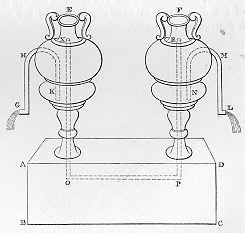If two vessels, both of them having visible outlets, stand upon a pedestal, and one of them be filled with wine, the other remaining empty, the wine shall not flow out until the empty vessel be filled with water ; and then a discharge shall begin, of wine from one, and of water from the other, until both are empty. Such vessels are all called
 harmonious goblets. Let A B C D (fig. 13) be the pedestal on which the
vessels, E and F, stand. In each of them place a bent siphon, G H K in
E,andL M N G in F, and let the outer extremities of the siphons be
shaped like water-pipes. At the bend the siphons must approach nearly to
the mouths of the vessels. Let another bent tube, X 0 P R, passing
through the pedestal, connect the two vessels, the extremities of which,
X and R, must reach as high as the bend of the siphons. Now pour wine
into one vessel, taking care that it does not mount higher than the bend
of the siphon at H. Up to this point the wine will not flow out, as
there is nothing to originate a discharge through the siphon. But if we
pour water into the vessel F, until its surface mounts above the bend of
the siphon at M, then the water will descend and pass through the pipe X
0 P R into the other vessel. Thus a discharge is occasioned of the wine
also, and both vessels will continue to run the one with wine, the other
with water until both are emptied.
harmonious goblets. Let A B C D (fig. 13) be the pedestal on which the
vessels, E and F, stand. In each of them place a bent siphon, G H K in
E,andL M N G in F, and let the outer extremities of the siphons be
shaped like water-pipes. At the bend the siphons must approach nearly to
the mouths of the vessels. Let another bent tube, X 0 P R, passing
through the pedestal, connect the two vessels, the extremities of which,
X and R, must reach as high as the bend of the siphons. Now pour wine
into one vessel, taking care that it does not mount higher than the bend
of the siphon at H. Up to this point the wine will not flow out, as
there is nothing to originate a discharge through the siphon. But if we
pour water into the vessel F, until its surface mounts above the bend of
the siphon at M, then the water will descend and pass through the pipe X
0 P R into the other vessel. Thus a discharge is occasioned of the wine
also, and both vessels will continue to run the one with wine, the other
with water until both are emptied.